The best chefs know that shiitake mushrooms are magic in the kitchen. Rich in umami flavor, this type of mushroom is a great addition to Asian cuisines. Plus, it can transform any bland recipe into a rave-worthy masterpiece. Shiitakes are also a sought-after ingredient in both vegetarian and non-vegetarian cooking, thanks to their meaty texture.
I’m a huge fan of sauteeing or roasting shiitake mushrooms and adding them to soups (like this Shiitake Mushroom Soup recipe) and salads as a topping, but there are tons of ways to use them. Whenever I develop a recipe for a vegetarian meal, I think of mushrooms as key ingredients. If you feel the same way, I know you’ll find today’s subject—cleaning shiitake mushrooms—helpful.
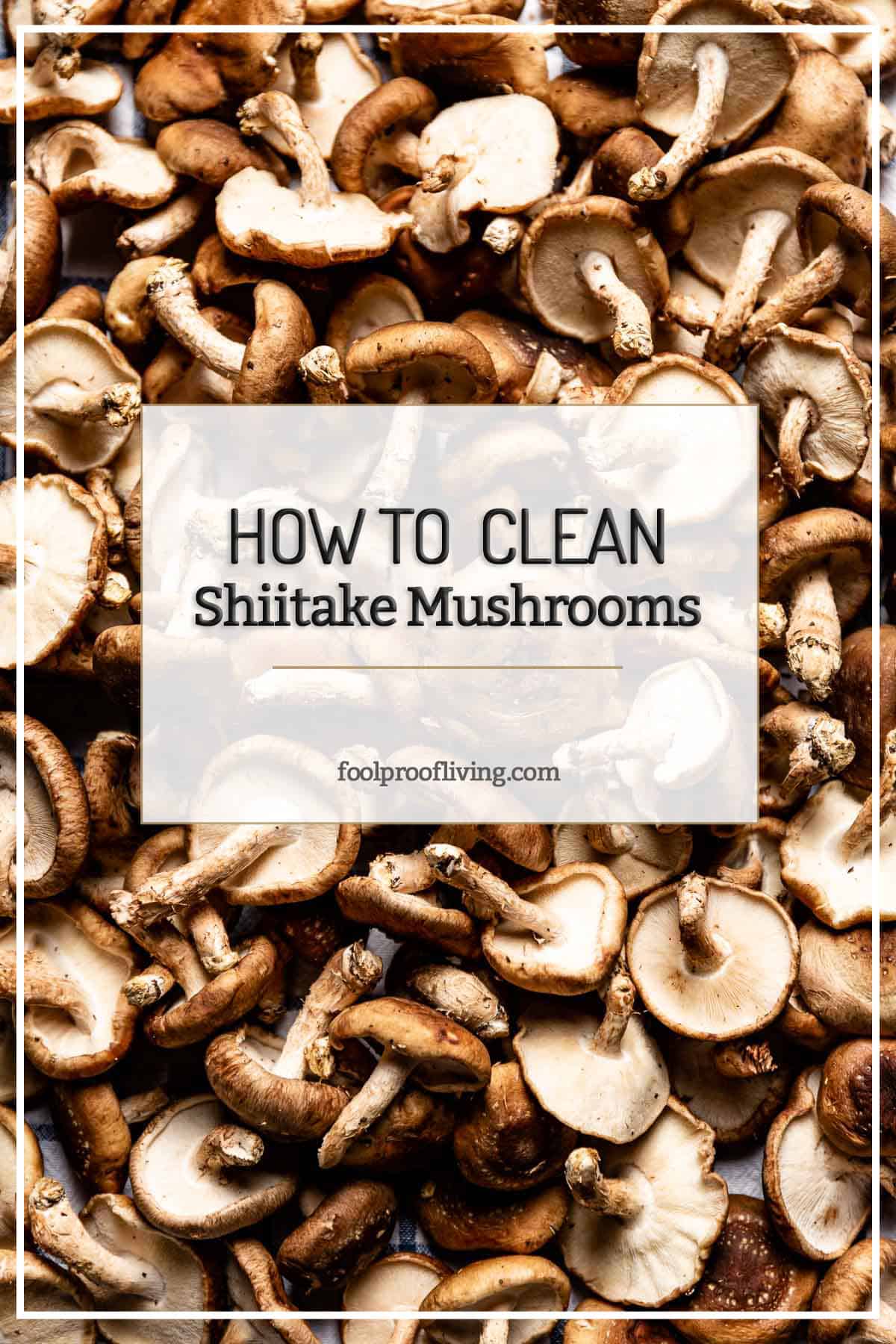
How To Wash?
I’ve always thought that washing shiitake mushrooms (or any kind of mushroom, for that matter) isn’t a good idea. In the past, I’ve heard many say that, when washed, mushrooms absorb additional moisture that leads to loss of flavor and longer cooking time.
However, I recently found out from this article on Cook’s Illustrated that rinsing mushrooms is actually okay. These pro chefs tested the myth by rinsing a batch of mushrooms and weighing them before and after. In the end, the weight difference was so minuscule that the chefs concluded that it’s okay to give mushrooms a quick rinse before use.
Now that we know it’s okay to wash mushrooms, let’s talk about how.
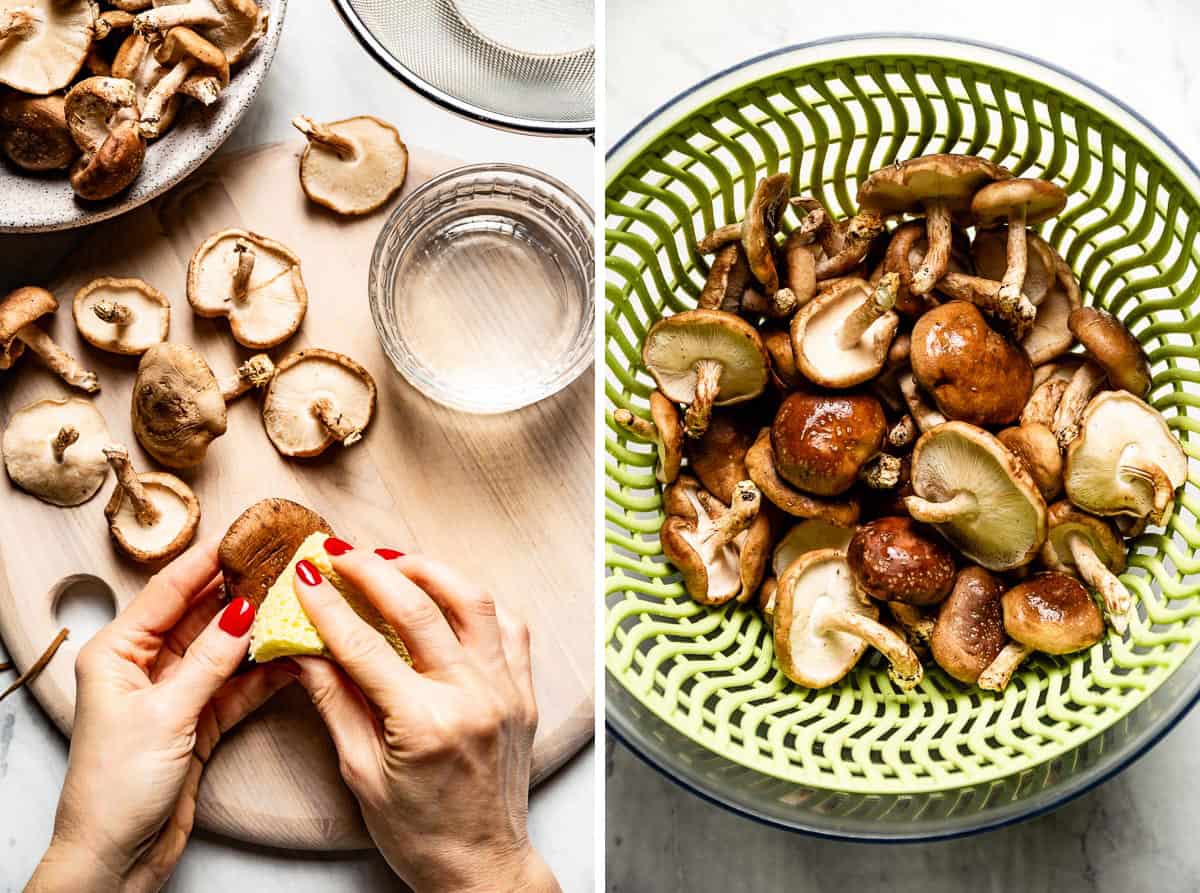
Wash One By One By Hand
While I think this method takes the longest, you can wipe each shiitake mushroom one by one using a damp paper towel.
To do so, wet a sheet of paper towel (a clean kitchen sponge or mushroom brush would also work) and gently wipe each mushroom cap. Make sure you turn it around and clean the back, too. While wiping, remove any visible dirt or debris hiding under or around the gills.
Furthermore, there’s no reason to clean the stems.
Using A Salad Spinner or A Colander
Because you can wash and dry many mushrooms simultaneously, using a salad spinner is the best way to clean mushrooms. Plus, it only takes minutes!
For this method, place your shiitake mushrooms in the salad spinner insert and rinse them under cold water for 30-45 seconds. While rinsing, gently move the mushrooms around with your hands to help remove any dirt or debris. Spin dry immediately to eliminate as much liquid as possible.
If you don’t have a salad spinner, you can use a colander. Simply give your shiitake mushrooms a quick rinse, wipe each one with a sheet of dry paper towel, and let them air dry.
Trim the Stems and Slice
It’s a popular myth that shiitake mushroom stems are poisonous and, as a result, inedible. However, this isn’t the case. In actuality, the stems of shiitake mushrooms are technically edible and are not poisonous. Still, most people choose not to use the stems because they have an unpleasant woodsy flavor and are too fibrous and chewy to eat.

To trim the stems, you can do one of the following:
- Turn the shiitake mushroom over, exposing both the gills and the stem. Then, gently pull the stem right where it meets the cap. It should snip right off.
- Use a paring knife and cut the stem off from the bottom of the gill.
Pro Tip: Don’t throw away the shiitake stems. Instead, save them to use later when making vegetable or chicken stock. These small pieces will enhance the flavor of broth-based soups by providing an umami-rich flavor.
How to cut shiitake mushrooms?
You can cook or roast shiitake mushroom caps as a whole or slice them thinly to use in your recipes. If you prefer to cut them, you can do one of the following:
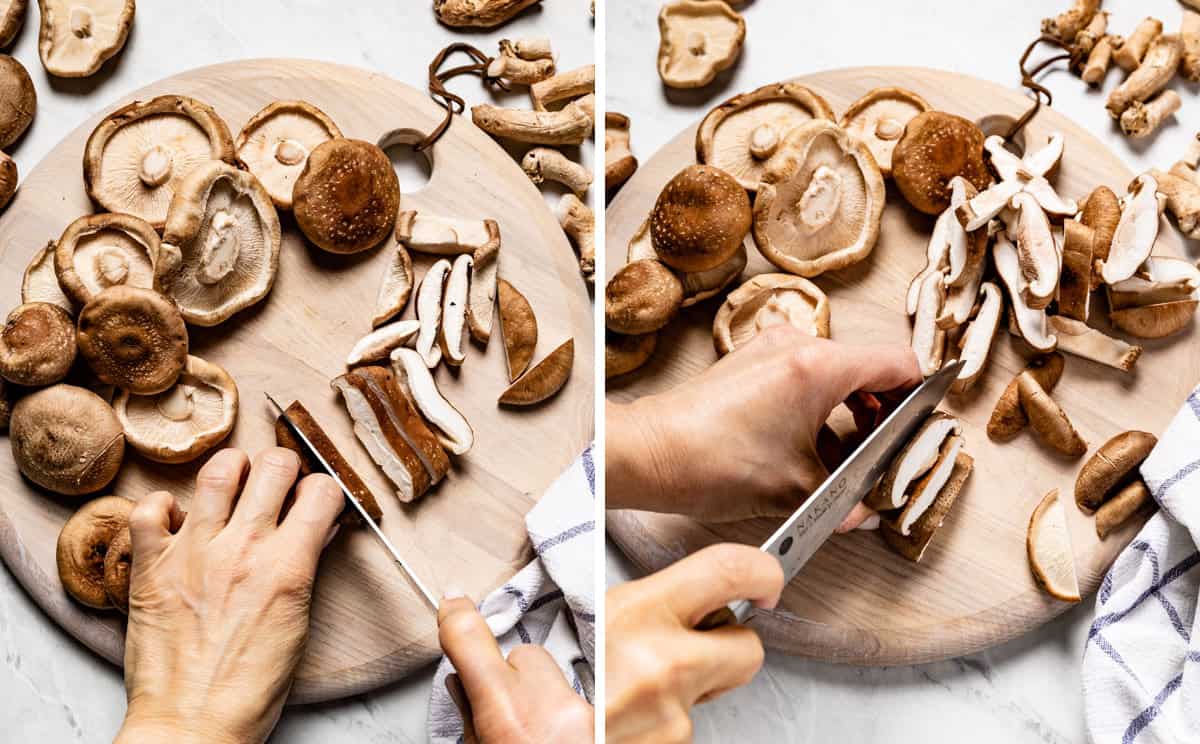
- Slice them one by one: Place the cap on a cutting board with the mushroom gills facing down. Then, cut it into thin slices.
- Stack them up: Place three to four mushroom caps on top of one another and slice them simultaneously.
How to Store Shiitake Mushrooms?
In this Complete Guide To Fresh Mushrooms article, the folks over Cook’s Illustrated say that “Maximizing the shelf life of mushrooms is all about balancing air circulation with moisture retention.” In other words, regardless of how you store them, fresh shiitake mushrooms must have a bit of breathing room.
- If you buy loose shiitake mushrooms: Place the mushrooms in a plastic bag, but don’t seal it tightly. Instead, leave the bag slightly open so that air can circulate.
- If you buy packaged shiitakes: Store the mushrooms in their original containers, as those are specifically designed to balance moisture retention and ethylene gas release. If you end up not using every mushroom, rewrap the container but poke a few holes to help air circulation. Source
Contrary to popular belief, storing mushrooms in a paper bag or wrapping them up with a damp paper towel is not a good idea. These methods will speed up your mushrooms’ deterioration.
How to Cook?
There are several ways of cooking shiitake mushrooms, but a few of my favorites methods are:
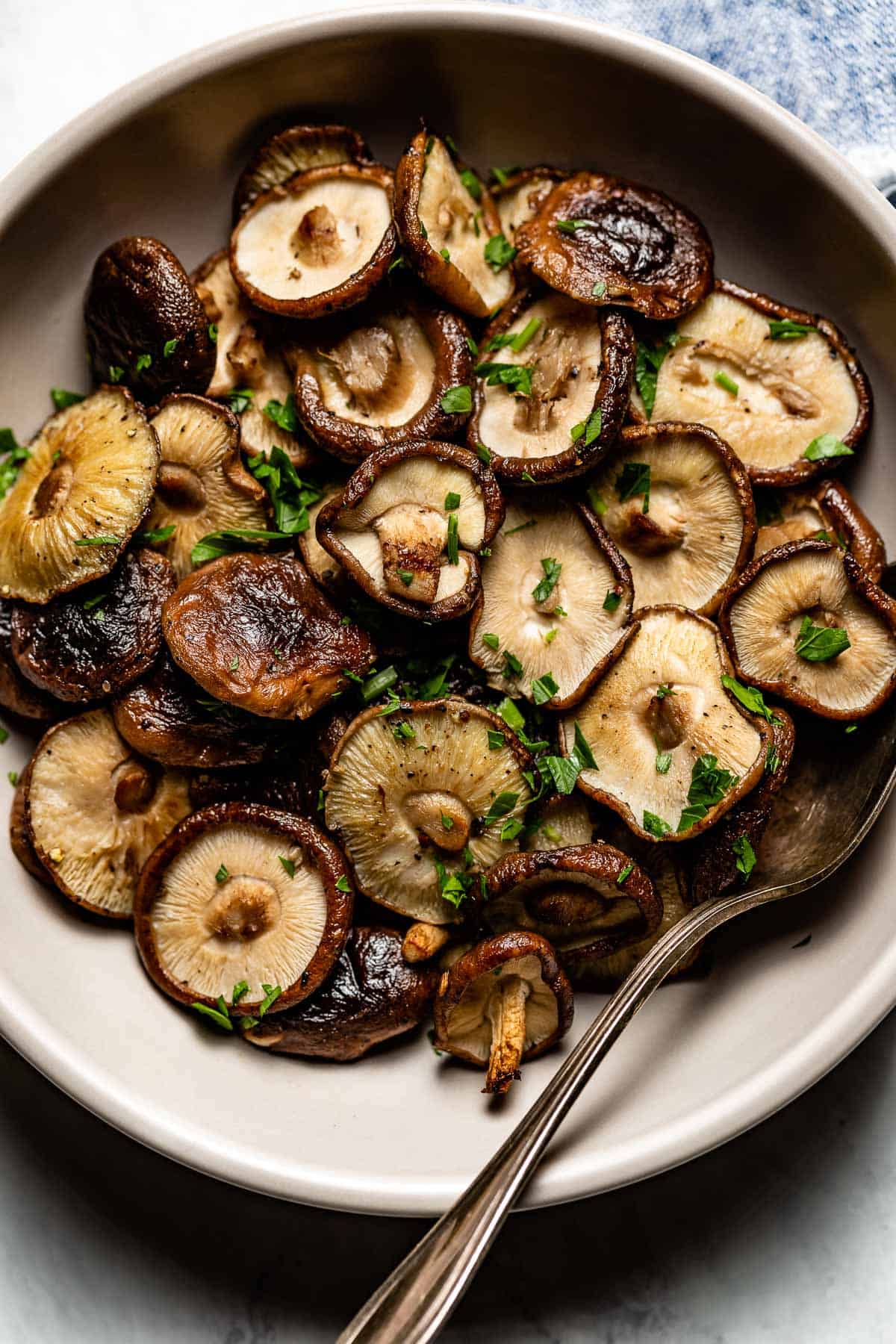
- Roasting them as a whole in the oven: Simply arrange fresh shiitakes on a baking sheet in a single layer, drizzle them with olive oil, and top them with salt and pepper. Then, bake the caps for a perfectly crisp and easy side dish. If you need an exact recipe, be sure to check out my guide for How To Roast Shiitake Mushrooms.
- Sauteed Shiitake Mushrooms: Pan-frying shiitake mushrooms with a bit of vegetable oil is also an excellent way to cook them. You can easily enhance their meaty flavor by incorporating other ingredients, too. For an extra Asian flair, saute them with a little bit of sesame oil and soy sauce. Or, for a Mediterranean vibe, saute them in butter and use them to make Shiitake Mushroom pizza.
FAQs
Also known as the Chinese black mushroom, Golden Oak Mushroom, and Lentinus edodes (its scientific name), shiitake mushrooms originate from the mountainous regions of East Asia, where it grows on fallen logs. It has been cultivated for over 1200 years and used for both medicinal and culinary purposes. Today, it’s commercially grown in China, Japan, the United States, and Brazil, with China leading production.
Unlike some of their fresh counterparts, like white button mushrooms and oyster mushrooms, shiitake mushrooms offer a nuttier, buttery taste and a chewier texture.
Shiitakes have large caps, measuring 2-4 inches wide. They also vary in color, ranging from light to dark brown, and have long, skinny, woody stems.
I recommend rinsing them under cold water for 30-45 seconds in a colander. You can also wipe them with a damp, clean cloth.
Yes, shiitake stems are technically edible. However, they have a fibrous and woody texture, making them less than ideal for recipes. Instead, I recommend using them while making meat-based or vegetable stock.
If you enjoyed or try my method of cleaning shiitake mushrooms, please take a minute to rate the below recipe and leave a comment below. It helps others who are thinking of making the recipe. And if you took some pictures, be sure to share them on Instagram using #foolproofeats so I can share them on my stories.

How To Clean Shiitake Mushrooms
Equipment
- 1 kitchen sponge or paper towels
- 1 salad spinner or colander
Ingredients
- 1 lb shiitake mushrooms, or more or less depending on your recipe
Instructions
To wash shiitake mushrooms you can follow one of the two following methods:
- Wash one by one: To do so, wet a sheet of paper towel (a clean kitchen sponge) and gently wipe each mushroom cap. Make sure you turn it around and clean the back, too. While wiping, remove any visible dirt or debris hiding under or around the gills.
- Using A Salad Spinner or A Colander (The easier & quicker method): For this method, place your shiitake mushrooms in the salad spinner* insert and rinse them under cold water for 30-45 seconds. While rinsing, gently move the mushrooms around with your hands to help remove any dirt or debris. Spin dry immediately to eliminate as much liquid as possible.
- To trim the stems: Turn the shiitake mushroom over, exposing both the gills and the stem. Then, gently pull the stem right where it meets the cap. It should snip right off. Or, Use a paring knife and cut the stem* off from the bottom of the gill.
- To slice them, you can place the cap on a cutting board with the mushroom gills facing down. Then, cut it into thin slices. Or, you can stack them up and slice them simultaneously.
Notes
- If you don’t have a salad spinner, you can use a colander. Simply give your shiitake mushrooms a quick rinse, wipe each one with a sheet of dry paper towel, and let them air dry.
- Don’t throw away the shiitake stems. Instead, save them to use later when making vegetable or chicken stock. These small pieces will enhance the flavor of broth-based soups by providing an umami-rich flavor.
- To store: If you buy packaged shiitakes, store the mushrooms in their original containers, as those are specifically designed to balance moisture retention and ethylene gas release. If you end up not using every mushroom, rewrap the container but poke a few holes to help air circulation.
If you bought loose shiitakes (not-packaged), place the mushrooms in a plastic bag, but don’t seal it tightly. Instead, leave the bag slightly open so that air can circulate.
Nutrition
Nutrition information is automatically calculated, so should only be used as an approximation.

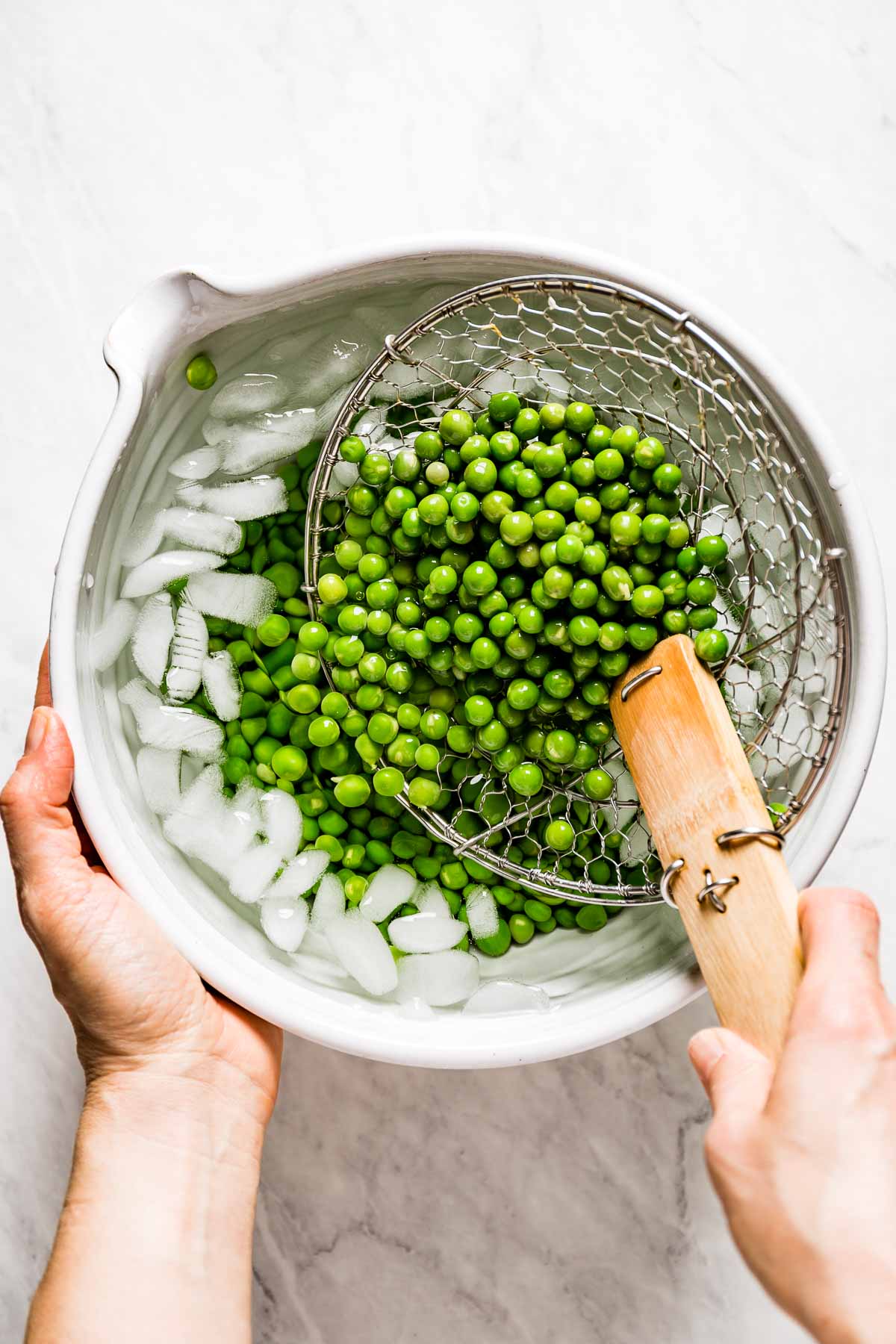

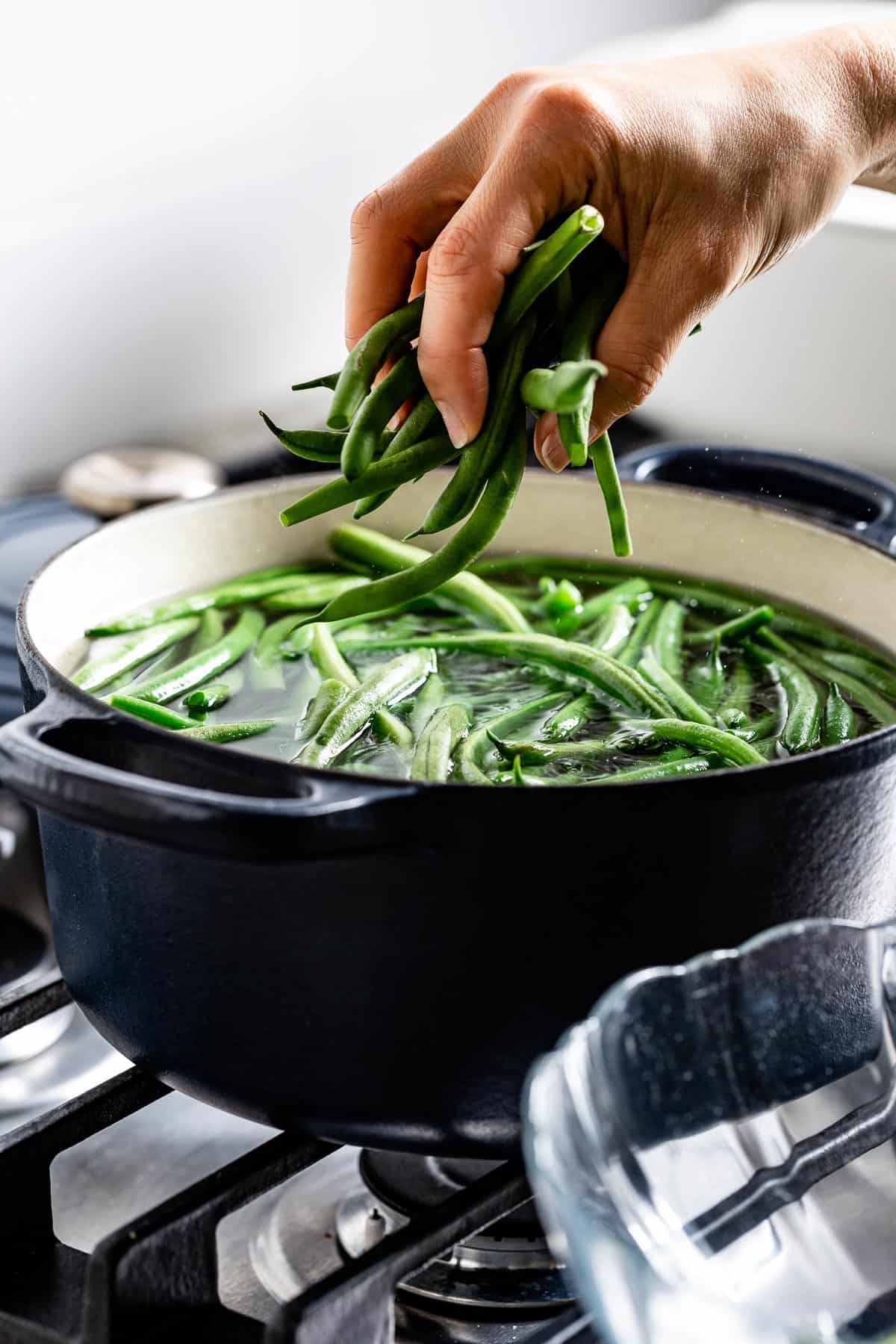










Thank you for this informative artical. But, I am confused. If it’s true that, in addition to the woody texture, “most people choose not to use the stems because they have an unpleasant woodsy flavor,” why would it be a good idea to use them to flavor a mushroom broth?
I prep shiitake mushrooms this way. After cleaning with a damp paper towel, I remove the bottom ¼-½” part of the stem which appears to be some of the substance on which the mushroom was grown and is very tough. Next, I place the shiitake, top down on my cutting board and slice it. When I come to the stem, I carefully slice it lengthwise, once or twice depending upon its thickness. This is the same method I use for cremini mushrooms. Neither my husband nor I have ever had a problem with either the flavor or texture of shiitake mushrooms when prepared this way. My husband has a very discerning palate.
I was using Shiitake recipes for the first time in a recipe this evening. This guide was SO HELPFUL! Thank you for the detailed information and instructions for cleaning and preparing them.
Hello Sue,
I am happy to hear that you found it helpful. Thanks for coming by and taking the time to leave a review.
Thank you, I have always avoided washing mushrooms but now I will wash them with confidence and feel better about it.
Thanks,
Laura
I am happy to hear that you found it helpful Laura. Cheers!
Thank youl